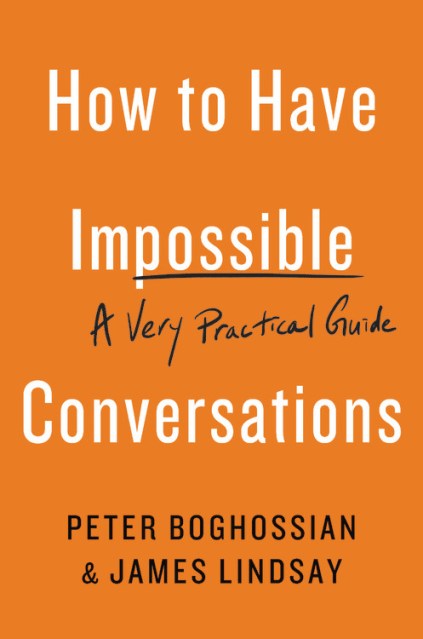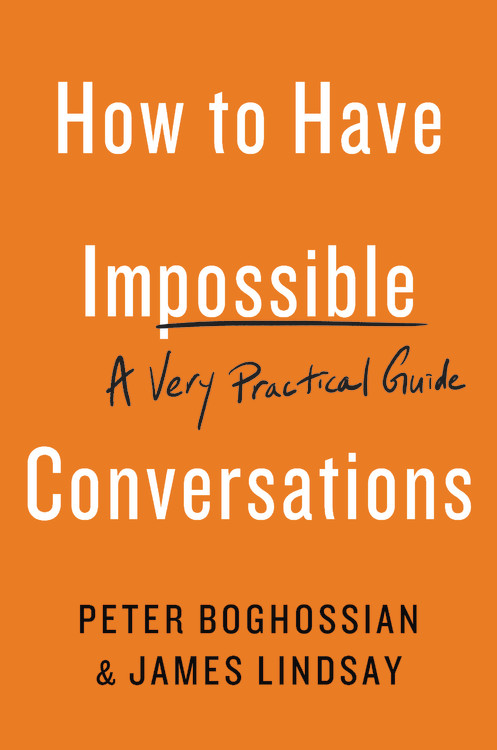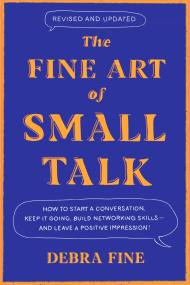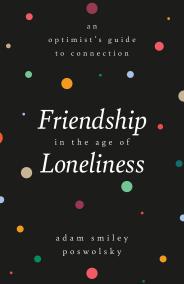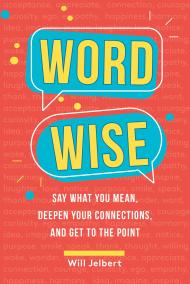Promotion
Use code MOM24 for 20% off site wide + free shipping over $45
How to Have Impossible Conversations
A Very Practical Guide
Contributors
By James Lindsay
Formats and Prices
Price
$19.99Price
$25.99 CADFormat
Format:
- Trade Paperback $19.99 $25.99 CAD
- ebook $11.99 $15.99 CAD
- Audiobook Download (Unabridged)
This item is a preorder. Your payment method will be charged immediately, and the product is expected to ship on or around September 17, 2019. This date is subject to change due to shipping delays beyond our control.
Also available from:
From politics and religion to workplace negotiations, ace the high-stakes conversations in your life with this indispensable guide from a persuasion expert.
In our current political climate, it seems impossible to have a reasonable conversation with anyone who has a different opinion. Whether you're online, in a classroom, an office, a town hall—or just hoping to get through a family dinner with a stubborn relative—dialogue shuts down when perspectives clash. Heated debates often lead to insults and shaming, blocking any possibility of productive discourse. Everyone seems to be on a hair trigger.
In How to Have Impossible Conversations, Peter Boghossian and James Lindsay guide you through the straightforward, practical, conversational techniques necessary for every successful conversation—whether the issue is climate change, religious faith, gender identity, race, poverty, immigration, or gun control. Boghossian and Lindsay teach the subtle art of instilling doubts and opening minds. They cover everything from learning the fundamentals for good conversations to achieving expert-level techniques to deal with hardliners and extremists. This book is the manual everyone needs to foster a climate of civility, connection, and empathy.
"This is a self-help book on how to argue effectively, conciliate, and gently persuade. The authors admit to getting it wrong in their own past conversations. One by one, I recognize the same mistakes in me. The world would be a better place if everyone read this book." —Richard Dawkins, author of Science in the Soul and Outgrowing God
In our current political climate, it seems impossible to have a reasonable conversation with anyone who has a different opinion. Whether you're online, in a classroom, an office, a town hall—or just hoping to get through a family dinner with a stubborn relative—dialogue shuts down when perspectives clash. Heated debates often lead to insults and shaming, blocking any possibility of productive discourse. Everyone seems to be on a hair trigger.
In How to Have Impossible Conversations, Peter Boghossian and James Lindsay guide you through the straightforward, practical, conversational techniques necessary for every successful conversation—whether the issue is climate change, religious faith, gender identity, race, poverty, immigration, or gun control. Boghossian and Lindsay teach the subtle art of instilling doubts and opening minds. They cover everything from learning the fundamentals for good conversations to achieving expert-level techniques to deal with hardliners and extremists. This book is the manual everyone needs to foster a climate of civility, connection, and empathy.
"This is a self-help book on how to argue effectively, conciliate, and gently persuade. The authors admit to getting it wrong in their own past conversations. One by one, I recognize the same mistakes in me. The world would be a better place if everyone read this book." —Richard Dawkins, author of Science in the Soul and Outgrowing God
Genre:
-
"This is a self-help book on how to argue effectively, conciliate, gently persuade. The authors admit to getting it wrong in their own past conversations. One by one, I recognize the same mistakes in me. The world would be a better place if everyone read this book."Richard Dawkins, author of Science in the Soul and Outgrowing God
-
"In a Free Republic there would be no 'impossible conversations', which begs the question: are we truly free anymore? After reading, listening and conversing with Peter and James, I am convinced that they are the Galileo's, I. Kant and even William Tynsdale of our time."Glenn Beck
-
"I thought I knew all I needed to know about conversations and arguments. I was wrong. I just knew a lot about debates and rows. In their insightful and highly readable new book, Peter Boghossian and James Lindsay offer all kinds of ingenious pathways to constructive dialogue. At a time when public discourse has degenerated into mud-slinging and when campuses favour every kind of diversity except viewpoint diversity, this is an invaluable contribution. I guarantee that reading it will make you more -- much more -- persuasive."Niall Ferguson, Milbank Family Senior Fellow, The Hoover Institution, Stanford
-
"In these polarized times, people live inside social media echo chambers of their own extremism, growing ever more self-righteous. This smart, scientifically grounded book, teeming with social and emotional wisdom, teaches how to break that isolation and effectively converse with someone with very different opinions. It will make you more adept at challenging, even changing, someone's beliefs, biases and sacred values. And it might even pave the way for making some of those changes yourself."Robert Sapolsky, John A. and Cynthia Fry Gunn Professor of Neurology and of Neurosurgery, Stanford University
-
"Drs. Boghossian and Lindsay offer critical advice regarding how to talk about contentious issues in today's political climate. How to Have Impossible Conversations is a necessary guide to navigating disagreements -- and building bridges -- using approaches backed by evidence and science."Debra W. Soh, Ph.D., science columnist and political commentator
-
"This fascinating book provides not only useful instruction on how to talk with someone who thinks differently, it also offers a powerful method of questioning and reducing confidence in unsubstantiated beliefs to help people think about what is true."Helen Pluckrose, Editor, Areo Magazine
-
"In the course of my work over the past quarter century I have been having impossible conversations with Holocaust deniers, creationists, anti-vaccination advocates, 9/11 Truthers, chemtrail conspiracy theorists, believers in astrology and ESP, proponents of alternative medicine, religious fundamentalists of many faiths, and dozens more people with whom I disagree vehemently. I've gotten pretty good at it but I had no idea what I was doing until I read How to Have Impossible Conversations, a sterling compendium of the most effective techniques of communication. I wish I'd had this important book at the start of my career as I would have saved myself many a fruitless dialogue. This book is the start of healing our contentious and divided age."Michael Shermer, Publisher Skeptic magazine, Presidential Fellow Chapman University, author of Why People Believe Weird Things, The Moral Arc, and Heavens on Earth, and for 18 years a monthly columnist for Scientific American
-
"We live in a time when discussing controversial issues, even with good friends, is becoming almost impossible. Peter and James have written an indispensable roadmap to prevent us from heading off the cliff."Dave Rubin, The Rubin Report
-
"We have arrived at an impasse. It is everywhere, and feels permanent. As algorithms steer our attention, we are each locked within a warren of echo chambers. Each day, this digital water we swim in causes a deepening entrenchment of our beliefs, and a growing willingness to caricature our opponents. When forced into contact with the other, we are repelled, indignant. How could anyone be so stupid? And we are shocked to discover the one thing that unites us with them is that they feel exactly the same way in return! It is not hard to spot the danger in this dynamic. It undermines the most basic logic of democracy, and threatens to derange the west, if not the world. But Boghossian and Lindsay have drawn up a plan to bridge the divide. They have bottled an antidote: A how to guide for talking to the enemy. Each drawing on decades of experience having impossible conversations, the authors have written what may be the ultimate instruction manual for crossing enemy lines and living to tell the tale. And not a moment too soon."Bret Weinstein, PhD
-
"There are two ways to participate in civil conversations in our hyper-politicized age -- build a time machine, or read this book."Marc Andreessen, General Partner, Andreessen Horowitz
-
"Everywhere that people gather and have a discussion -- every bar, cookout, and water cooler -- should have a copy of this book nearby. It might lower the temperature of our disagreements, and help us learn a few things from each other instead of just defending our own biases at the top of our lungs."Tom Nichols, author of The Death of Expertise
- On Sale
- Sep 17, 2019
- Page Count
- 272 pages
- Publisher
- Da Capo Lifelong Books
- ISBN-13
- 9780738285320
Newsletter Signup
By clicking ‘Sign Up,’ I acknowledge that I have read and agree to Hachette Book Group’s Privacy Policy and Terms of Use
